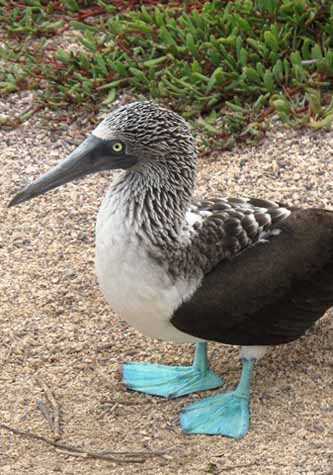Today is our first full day in the Enchanted Isles. Early in the morning, we set off at North Seymour, one of the jewels of the archipelago. This small and flat island is the home to various species of marine birds, as highly productive waters surround it. One of the most charismatic species of birds found in the archipelago is the blue-footed booby; today we discovered that they have begun their breeding season at North Seymour, and we were delighted to observe many new couples practicing their famous “booby-dance” showing off their beautiful blue feet to each other. There are two species of frigatebirdss in the Galápagos Islands: the great and the magnificent frigatebirds. Both species occur in North Seymour, and in most cases they nest next to each other. We are in the middle of the breeding season of the magnificent frigatebirds, many of which were courting and mating before our very eyes. The red pouches of the males were striking, and their aerial acrobatics were fun to watch. Along the shoreline, several Galapagos sea lions were resting after their long hunting trips in the sea, while a couple of very young pups waited patiently for their mothers to return to them. A large population of Galapagos land iguanas inhabits this tiny islet, and thanks to the mild weather and cloud coverage, we were able to see many of them quite actively looking for food. Iguanas are mostly vegetarian, and they have a strong preference for prickly pears and the flowers of the Opuntia cacti.
By 2.30 p.m., we had already navigated to our next destination: Rabida Island. Rabida has a distinctive red coloration due to the high amount of iron oxide in its lavas. Several Galapagos sea lions were lying on the red sand, as well as some marine iguanas that soaked in the sunshine. The leeward side of the island is the perfect location to enjoy the underwater world of Rabida Island. Many of our guests joined the deep-water snorkeling activity of the afternoon; this was a very successful outing, as there were several white-tipped reef sharks cruising along the shore, as well as a manta ray and several large aggregations of reef fish, like the razor surgeon, king angel fish and blue-chin parrot fish.
A stroll along the trail of Rábida allowed us to appreciate the beauty of the island, and its land birds like the Galapagos mockingbird, ground finches and Galapagos flycatchers. The sun was setting over the slopes of the distant volcanoes of Isabela Island... what a wonderful sight, and we delighted in the feeling of isolation in this far away archipelago: this is the magic of the Galapagos Islands, and we can’t wait to begin a new day in this forgotten paradise.







